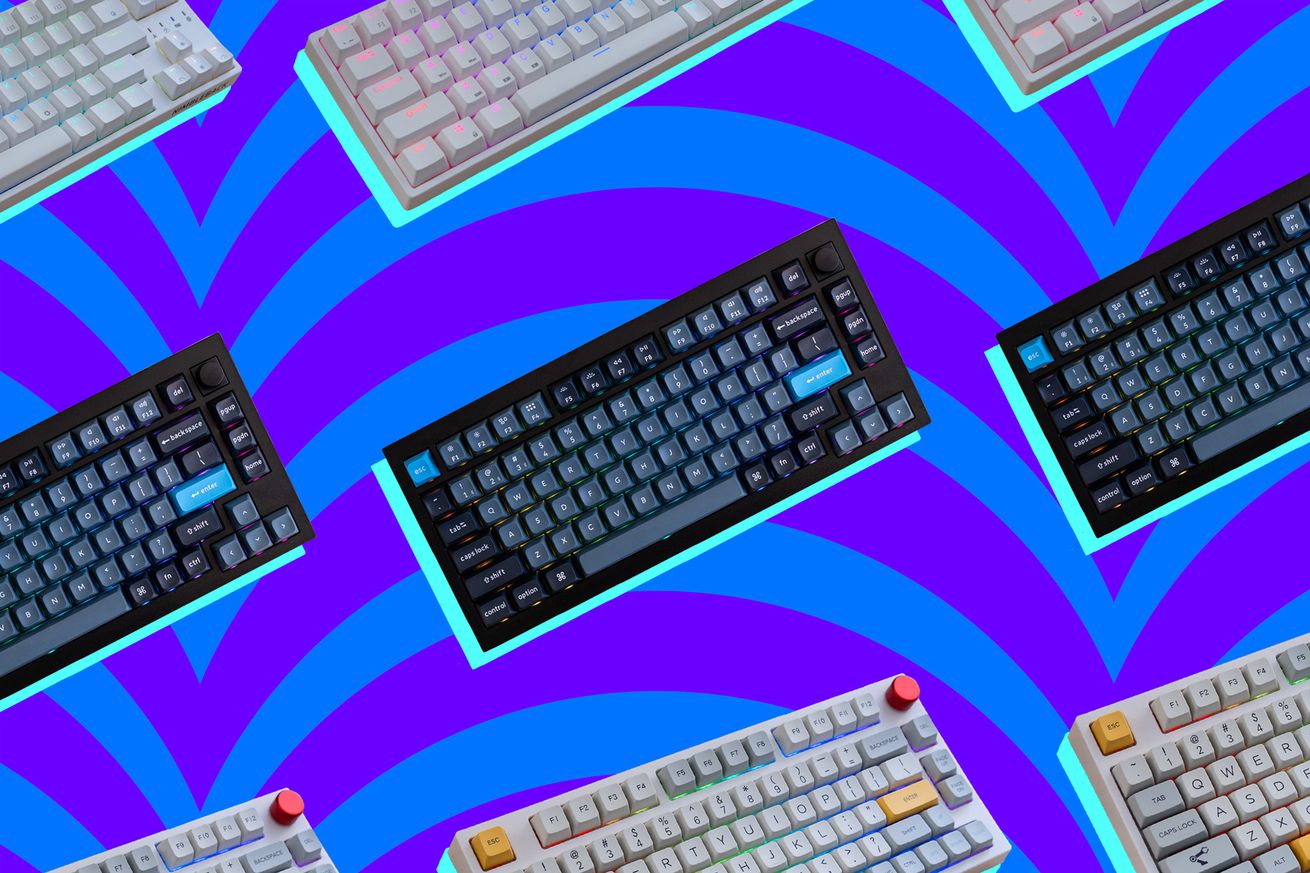- by foxnews
- 14 Mar 2025
The best mechanical keyboards to buy right now
Whether wired, wireless, or low profile, here are our picks for the best readily available boards.
- by theverge
- 09 Oct 2024
- in technology

Most of the keyboards below use a 75 percent layout, which is a compact form factor that maintains a function row and arrow key cluster, like most laptop keyboards. It's a great place to start unless you really want an attached number pad or know you prefer a different layout. Nearly all of our recommendations also come in other layouts, which we've linked where possible.
While any keyboard can be used for gaming, this guide focuses on the best keyboards for typing and general office work, so input latency and polling rate weren't major deciding factors. If you're after a keyboard specifically for gaming, check out our guide to the best gaming keyboards.
The best wired keyboard for most people
Keychron V1$60$8429% off$60$60$8429% offThe Keychron V1 is the best entry-level wired mechanical keyboard. It has hot-swappable switches, full remappability with VIA, great build quality, RGB backlighting, and double-shot PBT keycaps for under $100.$69 at Keychron$60 at Amazon
Connectivity: USB / Keycaps: Double-shot PBT / Hot-swappable: Yes / Available sizes: 60 percent, 65 percent, 70 percent, 75 percent, TKL, 1800, Full size, 65 percent Alice, 75 percent Alice / Available layouts: ANSI, ISO / Switch options: K Pro Red, K Pro Blue, K Pro Brown / Battery size: N/A / North- or south-facing switches: South-facing
The Keychron V1 is the best entry-level wired keyboard. Starting at just $84 for a fully assembled model (though frequently on sale for less), it's among the more affordable options on this list, but it feels almost as nice to type on as keyboards that cost twice as much. Its build quality is lovely and sturdy, and it sounds great to type on.
While the V1 has a 75 percent layout, a popular compact design that omits the numpad and other keys to give you a laptop-style experience, Keychron has other V-series keyboards in a variety of sizes. These range from more traditional keyboard layouts like the tenkeyless V3 and full-size V6, to more compact models like the V2 (which has a 65 percent layout that omits the dedicated function row) and the even more compact V4 (with a 60 percent design that omits the arrow keys entirely). Some V-series keyboards are also available in international layouts.
For such a low price, the V1 is packed with features usually found on enthusiast keyboards. It offers hot-swappable switches with south-facing RGB backlighting, and its switches and stabilizers feel nice and smooth. It's fully programmable: you can remap every key using the intuitive and powerful VIA software on top of QMK - which works on Windows, Mac, and Linux and lets you do everything from moving keys around to programming macros directly into the keyboard itself.
The V1 comes with durable double-shot PBT keycaps. You get a choice of Mac and Windows keycaps in the box, and a switch on the back of the keyboard lets you toggle between layouts instantly. You can get it with a volume knob for an extra $10 (pictured) or save $20 and buy a bare-bones version without keycaps or switches. Our sample came with Keychron's own tactile K Pro Brown switches, but there are also clicky and linear options.
If wireless connectivity is important to you, then Keychron offers the Keychron V1 Max, which can connect to your computer using either Bluetooth or a 2.4GHz USB dongle. It also uses a more premium-feeling gasket-mounted construction, which makes for a nicer typing feel. We seriously considered recommending the V1 Max over the V1, but decided against it for now. The V1 Max has a higher starting price, partly because it comes with a volume knob as standard and partly because the V1 is frequently discounted. And secondly, the wired V series that the V1 is a part of is - as outlined above - available in a wider choice of sizes and international layouts, meaning it's more likely that you'll find a model that suits your needs.
Expect this to change in the coming months; the V Max series is already available in six layouts (compared to nine for the V series), but for now the V1 remains our top pick for most people.
The best premium wireless keyboard
Keychron Q1 Max$209The Keychron Q1 Max is a great premium keyboard, with a full aluminum chassis, gasket-mounted plate, and the flexibility of either Bluetooth or 2.4GHz wireless connectivity in addition to the hot-swappable switches and VIA compatibility of the more affordable V series.$209 at Keychron$230 at Amazon
Connectivity: USB, Bluetooth, 2.4GHz dongle (1000Hz) / Keycaps: Double-shot PBT / Hot-swappable: Yes / Available sizes: 11 options, ranging from 60 percent to full-sized and beyond / Available layouts: ANSI, ISO / Switch options: Gateron Jupiter Red, Gateron Jupiter Brown, Gateron Jupiter Banana / Battery size: 4,000mAh / North- or south-facing switches: South-facing
If you're after something fancier than the V1 and the rest of Keychron's V-series, the Keychron Q1 Max is a great step up. It has a sturdy aluminum chassis with a built-in volume knob, offers a much nicer typing experience, it's fully customizable, and it's wireless, with an option to connect over either Bluetooth or an included 2.4GHz USB dongle.
If you're considering a premium keyboard, we think it makes sense to pick the Keychron Q1 Max over the Q1 Pro ($199) or wired Keychron Q1 ($189 with knob). The Max has all the features of the earlier two boards, with the extra flexibility of connecting via a 1000Hz 2.4GHz USB dongle in addition to Bluetooth and USB-C. The same goes for the rest of the Q Max series.
If you're happy with a "good" rather than "great" typing feel, then many of the Q1 Max's most compelling features - like VIA programming, hot-swappable switches, and per-key south-facing RGB backlighting - are also available on the wired V1 and wireless V1 Max above as well as Keychron's other V-series boards.
Use the keyboard wirelessly, with its RGB lighting disabled, and the Q1 Max can happily go for weeks without needing to be recharged. But turn on its backlighting, and its rated battery life drops by around half. The reliability of the 2.4GHz connection was flawless in my testing - I didn't experience any dropouts during a month of use.
In addition to its sturdy aluminum case and wireless connectivity, the other advantage the Q1 Max has over the V1 (though not over the V1 Max) is its gasket-mounted construction, which gives it a more premium typing feel. By effectively suspending its polycarbonate switch plate and PCB between gaskets, the keyboard has a substantial amount of flex to it. That might not sound preferable, but it gives the Q1 Max a much more satisfying typing sound compared to what are known as tray-mounted keyboards like the Keychron V series. Replacement switch plates are also available in different materials if you want to further customize how the Q1 Max feels and sounds.
A potential downside of the Q1 Max is that its battery life is only great if you turn off its RGB lighting. It's also very heavy compared to some of the other wireless keyboards on this list, which means it's not a great pick if you plan to use the keyboard while out and about.
Like most of Keychron's other boards, the Q Max series is available in a wide range of different layouts. Sizes range from the compact Q60 Max through to the full-size Q6 Max. So unless you're after a niche layout like the 40 or 70 percent, you should be able to find the right size for you.
A great low-profile wireless mechanical keyboard
Lofree Flow84$136$15914% off$136$136$15914% offThe Lofree Flow84 is a sleek low-profile mechanical keyboard with a 75 percent layout and hot-swappable switches. It offers a nice typing feel and great build quality, though its customizability options are limited. $136 at Amazon$159 at Lofree
Connectivity: USB, Bluetooth / Keycaps: PBT Dye-sub / Hot-swappable: Yes / Available sizes: 75 percent / Available layouts: ANSI / Switch options: Kailh low-profile Phantom tactile, Kailh low-profile Ghost linear / Battery size: 2,000mAh / North- or south-facing switches: North-facing
Low-profile mechanical keyboards offer much of the tactility and durability of typical mechs but with a squatter design that might feel more familiar if you've spent a lifetime typing on laptop-style keyboards. Of these, we recommend the 75 percent Lofree Flow84 (formerly known as the Lofree Flow), which has great battery life and a premium aluminum construction.
The Flow84's specs are similar to those of the NuPhy Air75, which was our previous low-profile keyboard pick. But Lofree's keyboard feels far better to type on, and it sounds better, too. The Flow84 is a wireless Bluetooth keyboard with a choice of either linear or tactile switches, and these switches are also hot-swappable, so you can change your mind later if you so choose. Know, however, that the switch pin layout means you're limited to Lofree's Kailh switches. The switches do use standard MX-style stems, and you can find compatible low-profile keycaps from NuPhy among others.
In my testing, battery life was good, with the keyboard still reporting 70 percent of its charge remaining after a month of daily use with the backlight off. Lofree advertises that the Flow84's battery life is 40 hours, which I can only assume is with the backlight on, giving you closer to a week of charge. You can connect it to a Mac or Windows machine wirelessly via Bluetooth or with an included USB cable.
There are a couple of other options to consider in this category depending on your needs. The NuPhy Air75 remains a great pick if you're on a tighter budget (its MSRP is $109.95), or if you'd prefer the lower input latency of a 2.4GHz dongle over Bluetooth for a wireless connection. There's also Logitech's MX Mechanical Mini, which lacks hot-swappable switches but benefits from a battery life that extends to as much as 10 months with its backlighting turned off.
Read our Lofree Flow review.
An affordable wireless 75 percent keyboard
Epomaker TH80 Pro$46$10054% off$46$46$10054% offThe Epomaker TH80 Pro is a well-equipped wireless mechanical keyboard. It's customizable and feels good to type on while also being relatively affordable.$54 at Amazon$46 at Epomaker
Connectivity: USB, Bluetooth, 2.4GHz dongle / Keycaps: Dye-sub PBT / Hot-swappable: Yes / Available sizes: 65 percent, 75 percent, 96 percent / Available layouts: ANSI, ISO / Switch options: Gateron Pro Red, Gateron Pro Brown, Gateron Pro Black, Epomaker Budgerigar, Gateron Blue, Gateron Pro Yellow / Battery size: 4,000mAh / North- or south-facing switches: South-facing
For an affordable wireless mechanical keyboard that isn't made by Keychron, we like the Epomaker TH80 Pro. The TH80 Pro feels fantastic to type on, supports Bluetooth connections to up to three different devices, and also includes a 2.4GHz wireless USB dongle if you don't want to mess around with Bluetooth pairing. We also like that it has separate Mac-specific keycaps in the box and that it's relatively light and portable compared to the Q1 Max.
Like the Keychron V1 and Q1 Max, the Epomaker TH80 is a 75 percent keyboard with hot-swappable switches and a volume knob. It has a plastic case and steel switch plate, and while it doesn't feel quite as high-end as Keychron's Q-series keyboards, it's got nice, crisp PBT keycaps in MDA profile, smooth stabilizers, and a typing feel that's on par with the slightly cheaper wired-only Keychron V1. Our review sample came with linear Gateron Pro Yellow switches, but other linear and clicky options are available.
The Epomaker TH80's layout can be remapped with software that works on both Mac and Windows computers. It's not as slick or powerful as the VIA app used by Keychron's boards but still lets you remap every key (aside from the Function key) with alternative keys or macros. (By contrast, VIA lets you move the function key, too, or add additional function keys for different layers.)
The TH80 doesn't have secondary functions printed on its keycaps, so you'll need to keep its manual on hand to remind yourself what they do. And while it features per-key RGB lighting (with south-facing LEDs), keeping the backlighting on in wireless mode absolutely tanks its battery life. I got just two and a half days of use over Bluetooth with the keyboard's RGB lighting set to maximum compared to eight workdays with the backlight off before I had to plug it in to recharge. Either way, you get much better battery life out of the more expensive Q1 Max.
Although the TH80 comes in our favorite 75 percent layout, Epomaker has a larger version with a numpad as well as a smaller 65 percent model. If you're on a tighter budget, the Royal Kludge RK84 is a little cheaper without compromising too much on typing feel, though its software is Windows-only and its layout is a little more smushed.
A more affordable wired 65 percent keyboard
LTC Nimbleback$40$5527% off$40$40$5527% offAlthough it can't match the typing feel of some of the more expensive keyboards on this list, the LTC Nimbleback is a feature-packed, affordable pick.$40 at Amazon$50 at LTC
Connectivity: USB / Keycaps: Not disclosed / Hot-swappable: Yes / Available sizes: 65 percent, 75 percent, Full size / Available layouts: ANSI / Switch options: Blue, Brown, Red (unbranded) / Battery size: N/A / North- or south-facing switches: North-facing
At less than half the price of some of the other keyboards on this list, the $55 65 percent LTC Nimbleback punches well above its weight. It's very full-featured for its price, with shine-through RGB lighting and hot-swappable switches, and it even has a built-in USB hub with a pair of USB Type-A ports to plug extra accessories into your computer.
As you might expect given the price difference, the LTC Nimbleback's construction isn't as solid as the Keychron V1's, and it doesn't feel as nice to type on as many of the picks above. Its switches feel slightly less smooth and more scratchy with each press, there's a slight rattle to the stabilizers on larger keys like the space bar, and it sounds a bit hollow overall. It's also made of plastic, and while it is reprogrammable, its companion software is only available on Windows. But the LTC Nimbleback's typing feel holds its own against more similarly priced competitors, including the $69 Keychron K6.
The LTC Nimbleback is available with clicky, linear, or tactile switches (we had the latter). If the model listed here looks a little too small for your liking, there are also 75 percent and full-size versions available.
A split ergonomic option
Kinesis Freestyle Pro$167$1797% off$167$167$1797% offThe Kinesis Freestyle Pro is a great split keyboard option, which allows you to keep your arms in a more neutral position while typing. It's not hot-swappable, but it has an easier to learn layout and more affordable price than other ergonomic options.$167 at Amazon$179 at Kinesis
Connectivity: USB / Keycaps: Not disclosed / Hot-swappable: No / Available sizes: Split / Available layouts: ANSI / Switch options: Cherry MX Brown, Cherry MX Silent Red / Battery size: N/A / North- or south-facing switches: North-facing
They're very much a niche option, but plenty of people swear by split keyboards, which are designed to let you type with your hands further apart and your shoulders in a more neutral position. Of these, we recommend the Kinesis Freestyle Pro.
It doesn't have hot-swappable switches, which means you're stuck with the Cherry MX Brown or Cherry MX Silent Red switches that it comes with unless you're willing to do some soldering. But at $179, it's relatively affordable by the often exorbitant prices of split keyboards (the ErgoDox EZ Original starts at $325, for example, while the ZSA Moonlander is $365), and it has a layout that's much closer to a traditional keyboard than a lot of other ergonomic options. It means there's less of a learning curve if you're coming from a standard keyboard layout.
That's not to say there aren't hot-swappable ergonomic options out there. We really enjoyed the ZSA Moonlander, for example. ZSA's Oryx configurator software offers a ton of options to create highly customized layouts, and optional accessories like an angled stand and tripod mounting kit mean you can tailor the keyboard to your exact needs. It also offers hot-swappable switches, which we normally consider an essential part of a modern keyboard, but we don't think that justifies the price premium for most people. But at $365, the Moonlander is, by some margin, the most expensive keyboard on this list, and its columnar layout and thumb clusters take a lot of getting used to. (Though ZSA does allow you to return the keyboard within 30 days of when you get it.)
If you absolutely must have the most customizable ergonomic option available, then the ZSA Moonlander is a great pick. But most people who just want a more ergonomic keyboard with a familiar layout will be satisfied with the Kinesis Freestyle Pro.
Additional reporting by Jay Peters.
Updated October 8th with new pricing.
- by foxnews
- descember 09, 2016
Southwest flyers fire back over airline ending free checked bag policy: 'Nail in the coffin'
Southwest has customers sounding off after the airline announced an end to its checked bag policy, leading some flyers to say they'll "boycott" the airline.
read more





